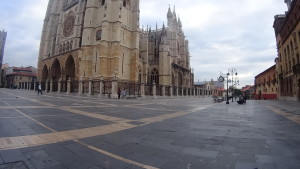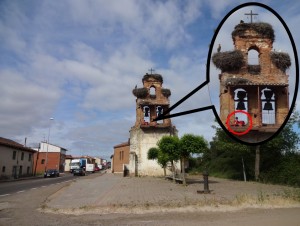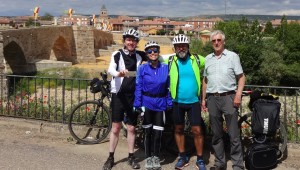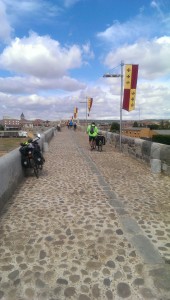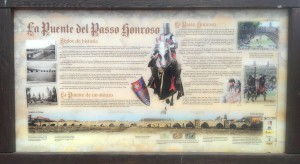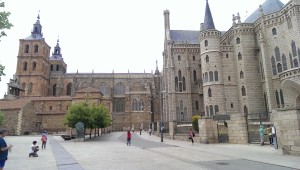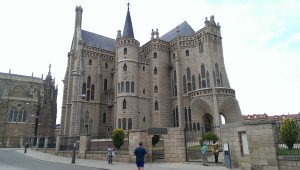
Welcome to another post about our Camino de Santiago Pilgrimage by bike. This one is special as it covers 2 days of our pilgrimage (well, essentially the was no pilgrimage on the 10th day). On the 2nd of June 2015 we rode 39.5 Km or 24.5 miles from Astorga to the village of El Acebo de San Miguel in 4h and 30m, of which 3h 21m were of actual moving time. On the 3rd of June we gave ourselves some time-off from the Pilgrimage. We woke up late and spent most of the day in the Hostel with a little walk around the village for lunch.
Day 9: From Astorga to El Acebo de San Miguel

I was the last to leave the hostel in Astorga that day, not a big surprise. Fernando had left an hour before and I left about 15 min after Marcelo and Alice did. It just took longer to pack the stuff in the bike that day, but then who cares? I wasn’t under any time pressure.
I believe this route from Astorga to El Acebo was one of the nicest in the Camino. It was also somewhat challenging as after Rabanal del Camino you are in for a long 8 Km climb of almost 500 m (from about 1,000m in Rabanal to about 1,500m just before the Iron Cross), but I am going ahead of myself again.

Just outside of Astorga on the LE-142 I came across the “Ermita del Ecce Homo” (Chapel of Ecce Homo or Jesus Christ) a house from the 17th Century where pilgrims can rest and refill their water bottles.
After Murias de Rechivaldo I left the LE-142 and took the same dirt track used by the walking pilgrims. The pilgrim traffic was quite intense which forced me to go slow, but I rode that dirt track for only about 3 Km until I reached the LE-6304 from where I rode on tarmac again to the village of Santa Catalina de Somoza.

This was likely the longest portion of dirt tracks I rode that day (plus a few minor ones not even worth mentioning). After Santa Catalina de Somoza I crossed through the village of “El Ganso” and continued on the LE-6304 towards Rabanal del Camino, where I met Fernando and stopped for something to eat and drink.

Few minutes later Marcelo and Alice arrived also and we all spent some time talking. It was then that a “figure” of the camino walked passed by us. I don’t know who this pilgrim was and I suspect he didn’t walk the way to Santiago as we met him a few more times until we reached Santiago, but the portions he walked he did dressed as a Templar and carrying a flag, so I guess you can understand why I called him a “figure” before.
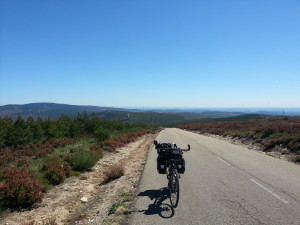
After Rabanal the long climb, as mentioned before, is rewarded by the views and the wild flowers and vegetation of various colours that grow alongside the road. The climb is long, but not very steep, making it perfectible manageable at least until some 500m past Foncebadón where it becomes steeper, perhaps about 15%, but is not very long. Both Fernando and I had to push the bike on that stretch.
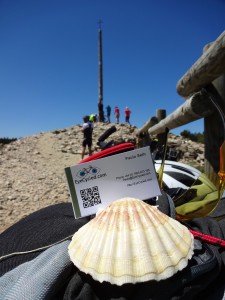
After Foncebadón we arrived at another landmark of the Camino: The “Cruz de Ferro” or Iron Cross, consisting of a wooden pole about 10m high surmounted by an iron cross. At its base there is a mound of stones that was formed over the years by Pilgrims that bring stones and leave them there. A legend says that when the Cathedral of Santiago de Compostela was being built, pilgrims were asked to contribute by bringing a stone.

The tradition is now to throw a stone there, brought from the place of origin of the pilgrim, symbolizing what the pilgrim wants to leave behind and get ready for rebirth on the last part of the Camino.

I didn’t bring any stone with me, but I think I left something behind and kept the satisfaction of having achieved it. Fernando and I arrived at the Cruz de Ferro together and Marcelo and Alice a few minutes later.
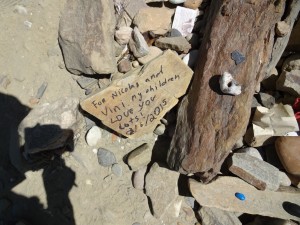
We spent quite some time there resting, talking and watching the other pilgrims arrive.
After the Cruz de Ferro there is a long and pleasant ride down all the way to El Acebo with some magnificent views of the mountains.

Fernando and I got separated from Marcelo and Alice who stopped at Manjarín, possibly attracted by the Brazilian flag and the many signs there.
As we arrived in El Acebo, I saw an ad about a recently opened Hostel and the pictures looked very good, especially the Olympic size swimming pool of t
he hostel. Fernando and I decided to check it out and almost could not believe our eyes. If there is such a thing as a 5 star pilgrims’ hostel, that must be it, but I´ll let the explanations for day 10.
The video below is a compilation of the climb towards the Cruz de Ferro.
The next video is of a view from the Cruz de Ferro and Fernando’s testimony.
Day 10: No cycling, just lazing up at the “La casa del peregrino“, a newly built “5-star” hostel in the camino.

Well, given the excellent facilities of this hostel and the price we decided to reward ourselves with a free day after the 520 Km of cycling since we had left Saint Jean Pied de Port 10 days earlier.

We could afford if both financially and in time as we still had 11 days left and only about 300 Km to go until Santiago.
Up to that point we had stayed in pilgrims’ hostels that were normally very simple in nature, with overnight costs varying from 5 € to 22 € (the first one in Saint Jean), but mostly around the 8 € to 10 € mark.

This hostel is also 10 €, but the value you get for your money is unbelievable. Mind you, it is still a hostel, in the sense that you sleep in rooms with several bunkbeds and share them with other pilgrims, but even that was amazing in this hostel.
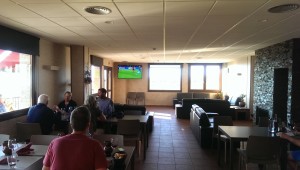
For 10 € you get a bed with your own individual light and 2 individual power sockets just for you (a luxury compared to other much older hostels) and your very own locker (reception provides a key).

Also Wi-Fi is available everywhere in the hostel (or at least it worked everywhere I tried, from our room to the common areas, but not in the pool).

You also get amazing views, laundry service (at a cost of 4 € per wash – there is also and outside washing area with clothes dryer if you, like me, want to hand wash your clothes) a little supermarket on the basement, a huge BBQ area, children’s playground, many outside sitting areas to enjoy the view, a bar, an always manned reception and believe it or not an “Olympic” size swimming pool with a crystal clear, but very cold, water that comes from the mountain.

The toilets, bathrooms, shower rooms are impeccably clean, modern and with an amazing hot water pressure. Everything is electronically controlled from the flow of water to the touch sensitive light dimmers (yeah, my geek side is taking over, sorry).

The room we stayed had 4 bunkbeds (8 beds), but on our 1st night we had the room just for us. On the 2nd night we were joined by 4 more pilgrims.
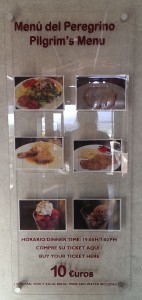
Not trying to diminish the old guest houses and hostels we stayed along the Camino, but it was refreshing to stay in a newly built place with all the benefits of the 21st century at our disposal.
Now, to the food… The pilgrims menu offers, as usual, 3 choices of a 3 course meal, accompanied by bread, water and wine. I think I will just let the pictures talk for me and say it was delicious. For 10 €, this is very hard to beat anywhere in the world, I think.
On that day we woke up late and walked to the village, as the hostel is about 200 m down the road.

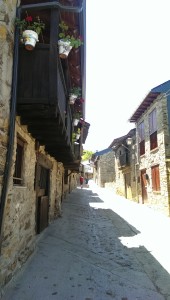
The village of El Acebo de San Miguel is tiny, with just a few houses along the main street, but there is an indescribable charm to it.

The houses are very old and a few appear to be in really bad shape (nothing more than a pile of stones, really). We walked to the top of the village where the water fountain is and had lunch at a place called “La Tienda”, which also offers rooms to Pilgrims. Like many other Spanish Villages along the Camino, El Acebo must be extremely dependant of the pilgrim tourism and it is likely that in high season a lot more pilgrims stay there than there are inhabitants.

Well, that’s it for days 9 and 10 of the pilgrimage. I´ll add a few more pictures below. Please feel free to leave comments, questions or at least indicate if you liked it or not by clicking on the stars in the bottom of the post.



